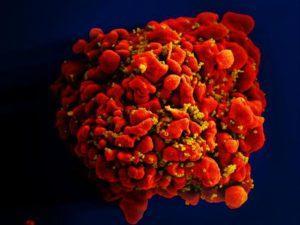
T cell (red) infected with HIV particles (yellow) (Public Health Image Library, NIAID, Image ID:18143)
More than 30 years after the discovery that HIV is the cause of AIDS, there is still no vaccine for this virus. One of the challenges in HIV vaccine design is that T cell-based vaccines have been shown to be ineffective at preventing viral infection. Focus shifted to antibody-based vaccines, however, the challenge lies in the induction of potent, broadly neutralizing antibodies (bnAbs) as they are more complex than most neutralizing antibodies. Researchers, led by Lynn Morris, reviewed current efforts to investigate precursors to bnAbs that target the V2 region at the apex of the HIV Envelope (Env) and from these data shed light on the progress towards a germline-targeting immunogen approach for HIV.
The V2-apex of HIV is one of the commonly targeted regions for HIV bnAbs. The V2 region is mostly variable, however, there are regions such as the glycan at position N160 , which are highly conserved. The conserved regions are the ones which are targeted by bnAbs. In 2009, the first bnAbs towards this site were isolated and from then on numerous others have been discovered.
For an antibody-based vaccine to be effective, most vaccinees must be able to produce the bnAbs required for protection against HIV. However, in natural infection, a very low percentage produce these antibodies. BnAbs are hard to make because of their unusual features including extensive somatic hypermutation, long complementarity-determining regions (CDRs) and autoreactivity. Therefore, ther is a need to understand how these antibodies emerge and how we can manipulate their faster development.
The use of an ontogeny-based immunogen may be the answer to elicit V2-apex-specific antibodies in vaccinees. Studies on germline precursors of V2-apex bnAbs have shown that they have long anionic CDR heavy chain 3 regions. These regions are usually deleted in the B cell repertoire so these antibodies are rare. Longitudinal studies have shown that these V2-apex bnAb precursors contain structural characteristics that enable them to neutralize antibodies and rapidly develop breadth with little somatic hypermutation. Structural analysis have also provided information of how to develop immunogens based on these precursor antibodies.
Altogether, more work is needed to understand how bnAbs develop their breadth and potency. Large steps forward have already taken place in the field in terms of understanding how precursors develop into bnAbs. With the ever-increasing arsenal of crystal and electron microscopy structures, knowledge of how these precursors form and bind at atomic levels will further aid the development of an effective HIV vaccine.
Journal article: Moore et al.,2017. Ontogeny‐based immunogens for the induction of V2‐directed HIV broadly neutralizing antibodies. Immunological Reviews
Article by Thandeka Moyo











